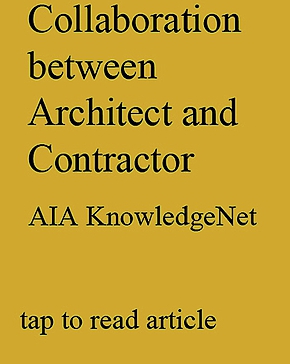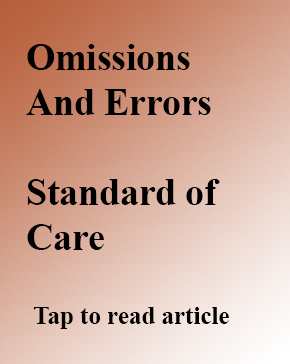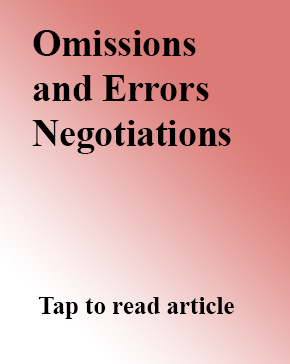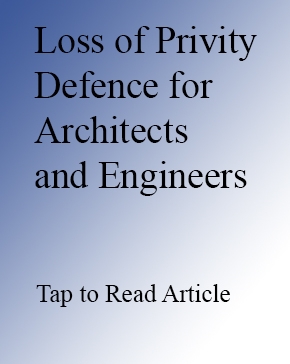Privity Defense and Economic Loss Rule
By Paul Potts
Interpretation in law identifies the meaning of words or actions, construction their legal effect.
 Until its decline over the last half-century the doctrine of privity, a common law principle inherited from British law, was impenetrable defense for architects and engineers against claims brought by third parties (those not signatory to the contract) even if personal injury or ancillary property damage was involved. Justice Benjamin Cordozo, sitting on the New York Court of Appeals in 1932, and later a Supreme Court justice, described the law this way: “The Law of Privity provides that suits against parties to a contract for negligence in performance of the duties and obligations of the contract could only be brought by signatories to the contract, not by third-party strangers.” The privity defense was so reliable that until fifty years ago many architects did not carry professional liability insurance. 1
Until its decline over the last half-century the doctrine of privity, a common law principle inherited from British law, was impenetrable defense for architects and engineers against claims brought by third parties (those not signatory to the contract) even if personal injury or ancillary property damage was involved. Justice Benjamin Cordozo, sitting on the New York Court of Appeals in 1932, and later a Supreme Court justice, described the law this way: “The Law of Privity provides that suits against parties to a contract for negligence in performance of the duties and obligations of the contract could only be brought by signatories to the contract, not by third-party strangers.” The privity defense was so reliable that until fifty years ago many architects did not carry professional liability insurance. 1
 In Black + Vernooy Architects v. Smith (2011) the architect was fully acquitted from paying damages to a claimant for life altering personal injuries that could have been prevented if the architect had taken anything more than a photographic interest in the construction of his design. The privity defense protected the architect not only from responsibility for economic damages to third parties, but also from damages for personal injury and ancillary property damage. These unfair social consequences of the privity doctrine eventually brought critical attention to the immunity provisions of privity that challenged jurists to find a legal construction that would allow suits against design professionals for personal injury and ancillary property damage (tort-like suits) to proceed where breach of contract was involved without making the contracting parties liable to a whole class of injured individuals for purely economic losses.
In Black + Vernooy Architects v. Smith (2011) the architect was fully acquitted from paying damages to a claimant for life altering personal injuries that could have been prevented if the architect had taken anything more than a photographic interest in the construction of his design. The privity defense protected the architect not only from responsibility for economic damages to third parties, but also from damages for personal injury and ancillary property damage. These unfair social consequences of the privity doctrine eventually brought critical attention to the immunity provisions of privity that challenged jurists to find a legal construction that would allow suits against design professionals for personal injury and ancillary property damage (tort-like suits) to proceed where breach of contract was involved without making the contracting parties liable to a whole class of injured individuals for purely economic losses.
Splitting the Atom
The historical origin of the privity doctrine was to reinforce the benefits of contract for professionals and manufacturers—securing predictable duties and obligations, providing measured and insurable risks and limiting liability to a known party in contract. Privity protected providers of professional services from claims by an unlimited collection of potentially injured third parties resulting from one negligent event, a potentially unlimited category of persons: 2 (see footnote 3532 Madison Ave. Gourmet Foods v. Finlandia Ctr., 750 N.E.2d 1097 (NY 2001)
Without privity or something like it, unpredictable exposure to claims by whole classes of parties rather than one known party in contract would increase the cost of liability insurance by factors that would make professional services prohibitively expensive and discourage people from entering the professions at all it was reasoned. This had to be balanced against the public interest in pursuing claims for bodily injury and ancillary property damage.
The Economic Loss Doctrine
In a 1965 product liability case, the California Supreme Court split the atom by circumscribing new boundaries in privity, allowing tort-like suits to be brought against contracting parties that were guilty of breach of contract causing personal injury or incidental property damage while still preventing suits for purely economic losses (in the construction context think of delay claims). In the California Products Liability case, Seeley vs White Motors (1965), the owner of a truck built by White Motors brought a suit against the manufacturer for damages (financial losses) his business incurred while he waited for repairs to his truck to be completed. The repairs were covered by the warranty, a form of contract, but the lost business profits were not, and the owner of the truck sued the manufacturer for the economic losses. It was an imperfect judicial ruling for our reasoning, almost a coincidental one based on product liability that did not hand any reward to the plaintiff.
The court denied the truck owner’s claim but redefined the protections of privity. In reaching a decision the court annunciated a new legal doctrine called the Economic Loss Rule (ELR), which did nothing for the truck owner but handed new protections for parties injured because of breach of contract. The ELR, which was quickly adopted by several states, preserved the privity-like defense against third parties for purely economic losses but allowed some tort-like actions against parties in contract for personal injuries and ancillary property damage because of breach of contract. The Court had split the atom, allowing third parties to sue those in contract for personal injury or ancillary property loss, but, denying claims for purely economic losses thus preventing contract law from being swallowed by tort law.
While privity defenses for architects and engineers were weakened by Seeley, the walls of the fort still stood. It took another 50 years of judicial tinkering with contract law, infusing it with tort remedies, for architects and engineers to find themselves in the heightened risk predicament they are in today.
The American Law Institute
Common law in the United States develops independently state by state, sometimes leaving large gaps in the law and irreconcilable differences from one state to another. The American Law Institute (ALI), a group of 3000 or more jurists, was established in 1923 “to promote the clarification and simplification of United States Common Law and its adaptation to changing social needs.”
The ALI does not dictate law, but its publications are widely read and often integrated into state common law. By periodically publishing what is referred to as “Restatements,” the ALI attempts to realign varying interpretations of different courts around central concepts in common law. In response to inconsistent applications of ELR, the group issued the “Restatement of Torts Second” in 1979 and the “Restatement of Contracts Second” in 1981. They became some of the most read and widely adopted provisions ever issued by the society. The restatements propagated ominous interpretations for architects and engineers.
Tort Law
Tort law proceeds from duties imposed by lawmakers and is intended to protect unsuspecting individuals from the unlawful acts of others (e.g. fraud, defamation or negligence) this contrasts with contract law where duties and obligations are created by signatories to the contract. Litigators prefer to raise tort issues at civil court instead of contract ones because tort law provides a wider latitude of opportunities and benefits for plaintiffs than contract law, and if not prevented from doing so, tort litigation would displace contract law altogether.
The “Restatement of Torts Second” reaffirmed the importance of the Economic Loss Rule as separating tort from contract law but provided tort with the power to pierce the immunities of contract law by allowing exceptions and ways around the economic loss rule. ALI declared where a contract existed or was implied, or a third-party beneficiary was established, the parties were limited in their pursuit of losses to the terms of the contract. This seems to reaffirm the protections of privity, but, the “Restatements” went on to define two exceptions to privity of contract – third-party beneficiaries and negligent misinformation.
Third-party beneficiaries of contract
The idea there could be a third party to the contract sharing the benefits of the contract but negotiating nothing away for it, and whose identity was unknown to the signatories of the contract at the time of signing is absurd; but, with publication of the “Restatement of Contracts, Second (1979),” the American Law Institute provided such a foundation.
ALI recommended using an ‘intent to benefit test’ to determine who could claim standing as a third-party beneficiary. The problem with a term like ‘intent to benefit’ is it could conceivably apply to any contractor or subcontractor that could benefit from the architect/engineer’s contractual duties and obligations to the owner. Fortunately for design professionals exclusionary third party declarations in owner-architect agreements are generally recognized to be definitive, and they successfully bar claims by potential third-party beneficiaries.
The Tort of Negligent Misinformation
In the “Restatement of Torts Second:” Section 552, “Information Negligently Supplied for The Guidance of Others,” ALI described the tort of negligent misinformation as: One who, in the course of his business, profession or employment, or in any other transaction in which he has a pecuniary interest, supplies false information for the guidance of others in their business transactions, is subject to liability for pecuniary losses if he fails to exercise reasonable care or competence in obtaining or communicating the information (negligence).
In Guardian Construction Co. vs. Tetra Tech Richardson, Inc. (1990 Delaware) the Court, in response to the defendant’s (architect’s) request for summary judgement on the basis of lack of privity, concluded: For the foregoing reasons, the Court concludes that as to the Plaintiffs’ claims that the negligently prepared project plans and specifications and the information conveyed at the pre-bid meeting were prepared and presented by TTR (the architect) for the use of a specific and limited class of potential users of which Plaintiffs (contractor) were known members, and because Plaintiffs were intended to and did rely to their detriment on that information in preparing their project bids, Plaintiffs’ negligent misrepresentation claims are cognizable despite the lack of contractual privity with TTR and the fact that Plaintiffs seek purely economic damages.
Conclusion
The traditional protections of privity for architects and engineers, while still functional in many states, Privity has been circumscribed in many states by the Economic Loss Rule allowing suits against those in contract for personal injury and property damage; and, courts using modern tort theory, Restatement Second of Tort (1979), provided by the American Law Institute (ALI) have created pathways for contractors to pursue tort claims against architects and engineers for negligent misinformation. Today, negligent misinformation claims have become the second most common category of professional liability claims behind owner claims.
While, architects and engineers have special insights into the work of contractors that make their active participation in the constructions of their designs essential to assuring compliance of the contractor’s work with the plans and specifications, design intent, and building codes, these unpredictable threats have made it risky for architects to carry out oversight obligations during construction. Courts should consider the risk of disocuraging architects and engineers from taking on any collaboration during construction.
While contractors have acquired an advantage in their risk relationship vis-a-vis the architect and engineer, architects and engineers have been saddled with more risk of an unpredictable nature. While owners have acquired a small benefit in this rearrangement of risk, they have lost considerably in the faithfulness of the design professionals to be their representative during construction.4
Architects and engineers have responded to this uncertainty by altering their standard owner-architect agreements to minimize their exposure to risk by decoupling themselves from oversight and responsibility for the contractor’s work; and minimizing collaboration with contractors believing verbal exchanges only increase the likelihood something spoken will be ammunition for a claim. 5
This article represents the research and informed opinion of the author and is intended for general information purposes only not constituting legal advice. Because the interpretation of common law varies from state to state the reader should consult with legal counsel familiar with the laws in their state.
Paul Potts is a freelance writer and for design and construction. He has worked in the construction industry as an independent contractor and administrator for architects, engineers, and owners. Potts can be contacted via e-mail at paulpotts1@comcast.net. Visit his website at www.pauljpotts.com.
Endnotes:
- AIA Trust: The Architect’s Risk” Two legal doctrines – the economic-loss rule and contractual privity – shielded architects from liability. These defenses were so effective that, only a handful of decades ago, many architects did not carry professional liability insurance.
- In 532 Madison Ave. Gourmet Foods v. Finlandia Ctr., 750 N.E.2d 1097 (N.Y. 2001), the New York Court of Appeals applied the Economic Loss Rule in cases involving construction disasters that resulted in streets being closed in the heart of Manhattan. Though nearby businesses were not physically damaged by the construction-related collapse, they either were evacuated and closed or were inaccessible to customers for long periods of time. The damages resulting were real and very substantial. However, the court held that a landowner did not have a common law “duty to protect an entire urban neighborhood against purely economic losses.” Id. at 1102.
- diminishes the architect’s authority to carry out their oversight obligations during construction: https://scholar.valpo.edu/cgi/viewcontent.cgi?referer=&httpsredir=1&article=1912&context=vulr
- reduced oversight of construction: http://scholar.valpo.edu/cgi/viewcontent.cgi?article=1912&context=vulr
- ammunition for a claim: http://www.theaiatrust.com/whitepapers/contractor-termination/






